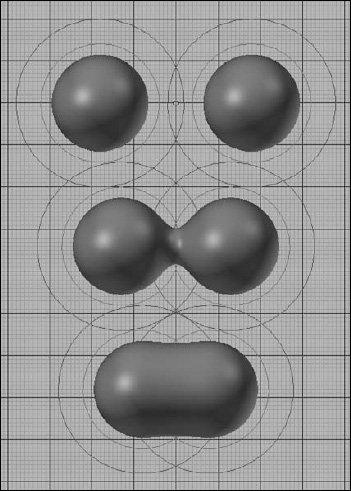Using Meta Objects
Meta objects are cool little 3D surfaces that have been part of computer graphics for a long time. Sometimes meta objects are referred to as blobbies. The principle behind meta objects is pretty simple: Imagine that you have two droplets of water, and you begin moving these two droplets closer and closer to each other. Eventually, the two droplets are going to merge and become a single, larger droplet. That process is basically how meta objects work, except you have complete control over when the droplets merge, how much they merge, and you can reseparate them again if you'd like.
You can also do something that's more difficult in the real world: You can subtract one droplet from the other, rather than add them together into a merged object. They're a ton of fun to play with, and there are some pretty neat applications for them. Figure 6-14 shows two metaballs being merged.
Figure 6-14: Merging two metaballs.

Meta-wha?
Meta objects are a bit like curves and NURBS in that their entire existence is defined by math. However, unlike NURBS or even meshes, you can't control the surface of a meta object directly with control points or vertices. Instead, the shape of their surface is defined by a combination of the object's underlying structure — a point, a line, a plane, a sphere, or a cube — and its proximity to other meta objects.
There are five meta object primitives: ...
Get Blender For Dummies®, 2nd Edition now with the O’Reilly learning platform.
O’Reilly members experience books, live events, courses curated by job role, and more from O’Reilly and nearly 200 top publishers.

